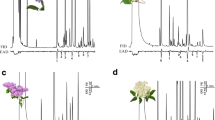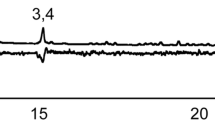Abstract
Field tests conducted in Leningrad Province of Russia showed methyl salicylate to be highly attractive to the dance fly Rhamphomyia (Amydroneura) gibba (Fallén, 1816) (Diptera, Empidoidea, Empididae). Yellow sticky traps baited with methyl salicylate caught similar numbers of males and females, although males somewhat prevailed at the beginning of the flight while females were slightly more numerous at its end. Rhamphomyia gibba is the first species of the family Empididae for which an attractant chemical is known, and methyl salicylate is the only attractant currently known for Empididae.
Similar content being viewed by others
References
Arthurs, S.P., Tofangsazi, N., and Cherry, R., “Attraction of Love Bugs (Diptera: Bibionidae) to Visual and Olfactory Stimuli,” Journal of Entomological Science 48, 291–298 (2013).
Boone, C.K., Six, D.L., Zheng, Y.B., and Raffa, K.F., “Parasitoids and Dipteran Predators Exploit Volatiles from Microbial Symbionts to Locate Bark Beetles,” Environmental Entomology 37, 150–161 (2008).
Buda, V. and Radžiute, S., “Kairomone Attractant for the Leafmining Fly, Liriomyza bryoniae (Diptera, Agromyzidae),” Zeitschrift für Naturforschung C 63, 615–618 (2008).
Buda, V., Radžiute, S., and Lutovinovas, E., “Attractant for Vinegar Fly, Drosophila busckii, and Cluster Fly, Pollenia rudis (Diptera: Drosophilidae et Calliphoridae),” Zeitschrift für Naturforschung C 64, 267–270 (2009).
Burov, V.N., Petrova, M.O., Selitskaya, O.G., Stepanycheva, E.A., Chermenskaya, T.D., and Shamshev, I.V., Induced Plant Resistance to Phytophages (KMK Sci. Press, Moscow, 2012) [in Russian].
Chvála, M., “Swarming, Mating and Feeding Habits in Empididae (Diptera), and Their Significance in Evolution of the Family,” Acta Entomologica Bohemoslovaca 73, 353–366 (1976).
Collin, J.E., “Empididae,” in British Flies, Vol. 6 (University Press, Cambridge, 1961), pp. 1–782.
Cumming, J.M., “Sexual Selection and the Evolution of Dance Fly Mating Systems (Diptera: Empididae; Empidinae),” The Canadian Entomologist 126, 907–920 (1994).
El-Sayed, A.M., The Pherobase: Database of Pheromones and Semiochemicals (2014). http://www.pherobase. com.
Gadino, A., Walton, V.M., and Lee, J.C., “Evaluation of Methyl Salicylate Lures on Populations of Typhlodromus pyri (Acari: Phytoseiidae) and Other Natural Enemies in Western Oregon Vineyards,” Biological Control 63, 48–55 (2012).
James, D.G., “Synthetic Herbivore-Induced Plant Volatiles as Field Attractants for Beneficial Insects,” Environmental Entomology 32, 977–982 (2003).
James, D.G., “Further Field Evaluation of Synthetic Herbivore-Induced Plant Volatiles as Attractants for Beneficial Insects,” Journal of Chemical Ecology 31, 481–494 (2005).
James, D.G. and Price, T.S., “Field-Testing of Methyl Salicylate for Recruitment and Retention of Beneficial Insects in Grapes and Hops,” Journal of Chemical Ecology 30 (8), 1613–1628 (2004).
Kido, M.H. and Asquith, A., “Attraction of Hawaiian Aquatic Insects to Pest Tephritid Parakairomone Lures,” Environmental Entomology 24, 810–816 (1995).
Knudsen, J.T., Eriksson, R., Gershenzon, J., and Stahl, B., “Diversity and Distribution of Floral Scent,” The Botanical Review 72, 1–120 (2006).
Lefebvre, V., Fontaine, C., Villemant, C., and Daugeron, C., “Are Empidine Dance Flies Major Flower Visitors in Alpine Environments? A Case Study in the Alps, France,” Biology Letters 10, 20140742 (2014).
Mallinger, R.E., Hogg, D.B., and Gratton, C., “Methyl Salicylate Attracts Natural Enemies and Reduces Populations of Soybean Aphids (Hemiptera: Aphididae) in Soybean Agroecosystems,” Journal of Economic Entomology 104, 115–124 (2011).
Rodriguez-Saona, C., Kaplan, I., Braasch, J., Chinnasamy, D., and Williams, L., “Field Responses of Predaceous Arthropods to Methyl Salicylate: a Meta-Analysis and Case Study in Cranberries,” Biological Control 59, 294–303 (2011).
Schiestl, F.P., “The Evolution of Floral Scent and Insect Chemical Communication,” Ecology Letters 13, 643–656 (2010).
Shamshev, I. and Grootaert, P., “Revision of the Genus Elaphropeza Macquart (Diptera: Hybotidae) from the Oriental Region, with a Special Attention to the Fauna of Singapore,” Zootaxa 1488, 1–164 (2007).
Sinclair, B.J., The Systematics of New World Clinocera Meigen (Diptera: Empididae: Clinocerinae) (NRC Research Press, Ottawa, 2008).
Smith, K.G.V. and Davies, R.G., “Gland-Like Abdominal Structures of Possible Epigamic Function in the Diptera,” Nature 207, 321–322 (1965).
Tollsten, L., Knudsen, J.T., and Bergström, L.G., “Floral Scent in Generalistic Angelica (Apiaceae): an Adaptive Character?” Biochemical Systematics and Ecology 22, 161–169 (1994).
Tuomikoski, R., “Phänologische Beobachtungen über die Empididen (Dipt.) Süd- und Mittelfinnlands,” Annales Entomologici Fennici 4, 213–247 (1938).
Tuomikoski, R., “Über die Nahrung der Empididen- Imagines (Dipt.) in Finnland,” Annales Entomologici Fennici 18, 170–181 (1952).
Tuomikoski, R., “The Ocydromiinae Group of Subfamilies (Diptera, Empididae),” Annales Entomologici Fennici 32, 282–294 (1966).
Wagner, R., “Remarkable Abdominal Appendages of Female Empididae and Male Dolichopodidae (Diptera: Empidoidea),” Entomologia Generalis 26, 253–258 (2003).
Author information
Authors and Affiliations
Corresponding author
Additional information
Original Russian Text © I.V. Shamshev, O.G. Selitskaya, 2016, published in Entomologicheskoe Obozrenie, 2016, Vol. 95, No. 4, pp. 758–764.
Rights and permissions
About this article
Cite this article
Shamshev, I.V., Selitskaya, O.G. Methyl salicylate as an attractant for the dance fly Rhamphomyia gibba (Fallén) (Diptera, Empididae). Entmol. Rev. 96, 1003–1007 (2016). https://doi.org/10.1134/S0013873816080054
Received:
Published:
Issue Date:
DOI: https://doi.org/10.1134/S0013873816080054




